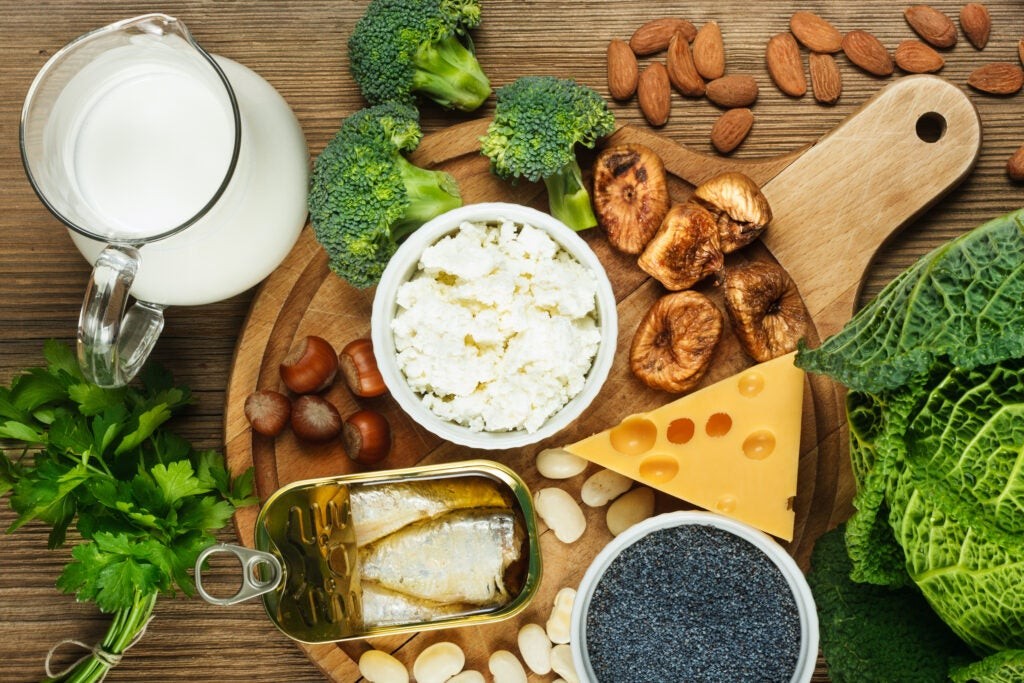Calcium is vital for strong bones and teeth, but it also plays crucial roles in blood clotting, muscle function, nerve transmission, and heart health. This article explores the best food sources of calcium, helping you ensure you’re getting enough of this essential mineral in your diet.
The human body diligently maintains a steady calcium level in the blood and tissues. When blood calcium dips, the parathyroid hormone (PTH) signals bones to release calcium. PTH also activates vitamin D to boost calcium absorption in the intestines and prompts the kidneys to conserve calcium. Conversely, when calcium levels are high, calcitonin lowers them by halting calcium release from bones and increasing kidney excretion.
We obtain calcium through calcium-rich foods or supplements and by drawing from calcium reserves within the body. Insufficient calcium intake forces the body to deplete calcium from bones. While ideally, this “borrowed” calcium would be replenished, it doesn’t always happen, even with increased calcium consumption.
Recommended Daily Calcium Intake
The Recommended Dietary Allowance (RDA) for calcium varies by age and gender:
- Women (19-50 years): 1,000 mg daily
- Women (51+ years): 1,200 mg daily
- Pregnant and lactating women: 1,000 mg daily
- Men (19-70 years): 1,000 mg daily
- Men (71+ years): 1,200 mg daily
Calcium and Health: More Than Just Bones
Calcium’s impact extends beyond bone health, influencing blood pressure, cardiovascular health, and even cancer risk.
Blood Pressure
Some studies suggest a link between total calcium intake (from food and supplements) and lower blood pressure. However, limitations in study designs prevent definitive recommendations to increase calcium intake beyond the RDA for treating high blood pressure. More extensive and longer-term trials are needed.
Cardiovascular Disease
 Various cheeses, nuts, broccoli, canned fish, and milk on a wooden board, highlighting calcium-rich dietary options.
Various cheeses, nuts, broccoli, canned fish, and milk on a wooden board, highlighting calcium-rich dietary options.
Some research has raised concerns about calcium supplements and heart health, with some studies suggesting increased risk of cardiovascular events with supplementation. This could be due to hypercalcemia (toxic calcium levels), potentially leading to blood clots or hardened arteries. However, a guideline from the National Osteoporosis Foundation and the American Society for Preventive Cardiology states that calcium from food or supplements has no relationship (beneficial or harmful) to cardiovascular disease in generally healthy adults. It advises against exceeding the Upper Limit for calcium (2,000-2,500 mg daily) from food and supplements.
Bone Health
Calcium is a critical nutrient for bone health. Bones undergo constant remodeling, with osteoblasts building bone and osteoclasts breaking it down. In youth, bone production surpasses destruction. After about age 30, destruction typically exceeds production, leading to bone loss. Adequate dietary calcium may slow bone loss, but won’t entirely prevent it. Calcium absorption also decreases with age.
Studies on calcium intake and bone density in postmenopausal women show mixed results, possibly due to factors like:
- Focusing solely on calcium from supplements without accounting for dietary calcium.
- Failure to adjust for hormone replacement therapy or other bone-preserving supplements like vitamin D.
Despite mixed results, the RDA for calcium is higher for postmenopausal women due to findings that higher calcium intakes (often through supplements) correlate with improved bone density and a slightly lower risk of hip fractures.
Colorectal Cancer
Epidemiological studies suggest high calcium intakes (from food and/or supplements) may protect against colorectal cancer. Randomized controlled trials using calcium supplements show mixed results, possibly due to short trial durations compared to the slow development of colorectal cancer.
Kidney Stones
Contrary to previous beliefs, insufficient calcium-rich foods can increase the risk of kidney stone formation. Research shows that a high intake of calcium foods decreases the risk for kidney stones in women, while calcium in supplement form increases the risk.
What Foods Contain Calcium? Beyond Dairy
Calcium is abundant in many foods, not just dairy. Fruits, leafy greens, beans, nuts, and some starchy vegetables are also good sources.
Bioavailability: How Much Calcium Does Your Body Actually Absorb?
The calcium amount listed on food labels indicates the total calcium content, not necessarily the amount absorbed by the body (calcium bioavailability). Dairy foods have about 30% bioavailability. Some plant foods, like leafy greens, have lower overall calcium but higher bioavailability.
For example, bok choy contains less calcium than milk per serving, but a higher percentage is absorbed. Calcium-fortified orange juice and calcium-set tofu have similar total calcium and bioavailability to milk. Almonds have slightly lower values.
Anti-Nutrients: A Word of Caution
Some plant foods contain oxalates and phytates, “anti-nutrients” that bind to calcium and reduce its bioavailability. Spinach, while high in calcium, also has high oxalate levels, limiting calcium absorption. It’s important not to rely solely on spinach for calcium.
Signs of Calcium Deficiency and Toxicity
Deficiency (Hypocalcemia)
While bones release calcium to maintain blood levels if dietary intake is insufficient, a more serious deficiency (hypocalcemia) can result from kidney failure, digestive surgeries, or certain medications.
Symptoms of hypocalcemia include:
- Muscle cramps or weakness
- Numbness or tingling in fingers
- Abnormal heart rate
- Poor appetite
Long-term inadequate calcium intake or absorption can lead to osteopenia and osteoporosis. Risk factors include:
- Postmenopausal women (due to decreased estrogen)
- Amenorrhea (disrupted menstrual periods)
- Milk allergy or lactose intolerance
Toxicity (Hypercalcemia)
Excess calcium in the blood (hypercalcemia) has an Upper Limit (UL) of 2,500 mg daily from food and supplements. People over 50 should limit intake to 2,000 mg daily, especially from supplements, to minimize risks like kidney stones and prostate cancer.
Symptoms of hypercalcemia include:
- Weakness, fatigue
- Nausea, vomiting
- Shortness of breath
- Chest pain
- Heart palpitations, irregular heart rate
Optimizing Calcium Intake: Key Takeaways
- Eat a Variety of Calcium-Rich Foods: Don’t rely solely on dairy. Explore leafy greens, fortified foods, and other non-dairy sources.
- Be Mindful of Bioavailability: Understand that not all calcium is absorbed equally.
- Consider Vitamin D: Vitamin D is crucial for calcium absorption. Ensure adequate vitamin D intake through sunlight, food, or supplements.
- Consult a Healthcare Professional: Discuss your calcium needs with your doctor or a registered dietitian, especially if you have specific health concerns or dietary restrictions.
- Don’t Overdo Supplements: Exceeding the Upper Limit for calcium can have adverse health effects.
By understanding What Food Contains Calcium and how to optimize its absorption, you can make informed dietary choices to support strong bones and overall health.
Last reviewed July 2024
